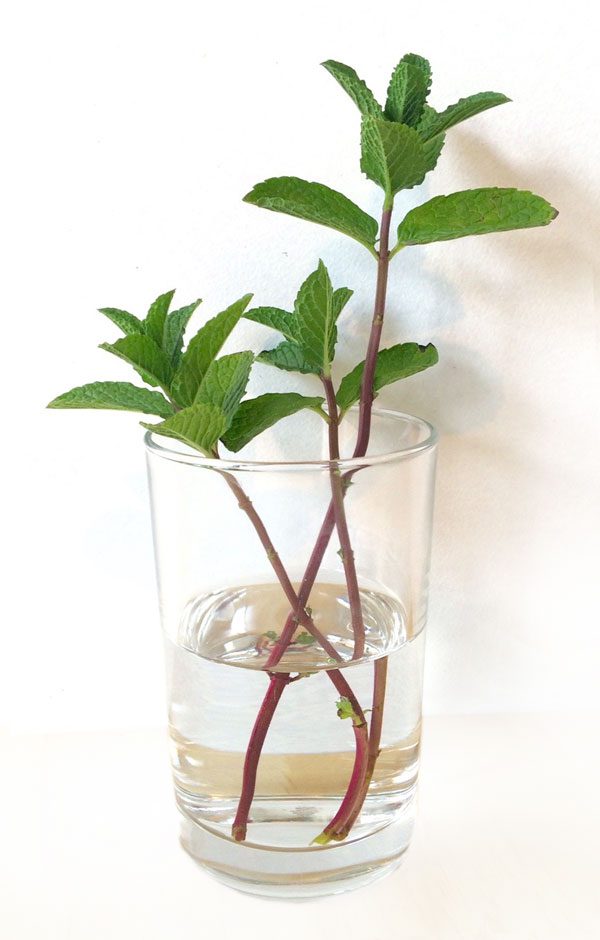The original and longer version of this article is published in UK4, where it appeared under the title, Grow Your Own Mint.
Cool, refreshing Mentha has graced herb gardens for thousands of years. There are 10 mint common hybrids, all of which prefer cooler climates and soil with consistent moisture. Guess what? You can easily grow it at home in some water!
PERKS & BENEFITS
Peppermint tea has been used forever to cure what ails you. Even modern healers regard mint as a stimulant and tonic, among its many other benefits. The herb is known for its aromatic, culinary, and healing qualities.
- Mint tea has antiseptic and antibacterial qualities. Consumed regularly, it’s a good blood cleanser, herbal mouthwash, natural diarrhea remedy, antiseptic, and helps to combat acne or blemishes.
- Bruised spearmint and peppermint leaves offer relief of migraines and aching muscles.
- Adding peppermint oil to lotions helps reduce pain and sensitivity.
- Strong mint oils also have anti-inflammatory, analgesic, and anesthetic properties for temporary relief of an infected tooth.
- It’s a good herbal remedy for swollen gums, mouth ulcers, mouth thrush, bruises, and swollen joints.
- Gauze pads wetted with peppermint tea minimize dark circles under the eyes, or refresh them on days you wake up not well-rested.
WHEN CAN I START AND HOW LONG DOES IT TAKE?

True mint plants are sterile, and cannot be grown from seed. You can start mint cuttings when healthy plants are available to purchase, usually in spring.
Using super sharp shears, take cuttings just below a leaf node from non-blooming stems about 4 inches long. You don’t want to crush the stem end. Remove a leaf or two from the bottom, and snip off the immature set of leaves at the tip. Dip the cut end in rooting hormone before inserting it into Rockwool cubes.
It takes one or two weeks to get your cuttings rooted nicely in hydroponic starter cubes. Finishing the crop can be done in slabs or directly in the NFT trough.
Expect the first of unlimited harvests four weeks after transplant in summer and six or seven weeks in winter. Mints are perennial and continue to produce future yields from the same roots.
If you’d rather use traditional potting methods, start your cuttings in a glass of tap water. New roots will grow in less than a week. Let it sit a few more days, and new stems will form at the leaf nodes.
Use a quality soilless mix that has excellent moisture retention with good drainage for potting. Remember that mint hates dry feet.
WHAT DO I NEED?
HID lamps and compact fluorescents running 14-16 hours a day will provide ample light for mint. Poor conditions and weak light make it prone to develop rust – an incurable and highly contagious plant disease. Do not buy plants with yellow or brown spots on either side of the leaf. If you find it on plants in your grow space, remove and destroy the plant immediately.
The sweetest flavor and heaviest oil yield come from warm days and cool nights. No special nutrient requirements here. A standard NPK hydroponic nutrient can be used. Their preferred pH range is 5.5-6.5. Maintain day temps of 75-80°F, nights at 55-60°F with 75-80% humidity in summer for rooting and vegetative stages. You want lower humidity in the winter to prevent leaf mold.
Use liquid or slow-release fertilizer in traditional container growing. Heavier feeding results in more abundant top growth. Be sure to maintain air humidity and keep the roots moist, but not waterlogged. Your yield will not be as high as plants grown hydroponically.
If you live in a cool climate and give it soil with good moisture retention, growing mint outdoors is easy. For perfect leaves, water regularly, and don’t let the soil dry. Mint is an excellent candidate for a wet spot in the yard or a self-watering container. It does fine with at least six hours of direct sun a day and good airflow. A slightly raised bed is wise; roots are shallow and spread quickly.
HARVESTING TIPS

A mint plant can produce harvests for up to 15 years. If you’re growing it indoors using traditional potting methods, you will need to divide and repot periodically to maintain good vigor. Rootbound container plants never perform the best they can.
For the best flavor, harvest mint leaves in the morning. Never cut in excess of two-thirds of the plant’s height.
Hydroponic NFT system harvest yield should be 2-3 pounds per 5-feet of trough in summer, and lower in winter at 1-2 pounds per 10-feet.
Bon Appetit!
Beyond breath freshening, mint helps with digestion. Add your fresh and flavorful mint to dishes including meat, fruits, vegetables, sauces, desserts, and beverages.
Enjoy!
Last updated by Catherine Sherriffs on 04/05/2020.